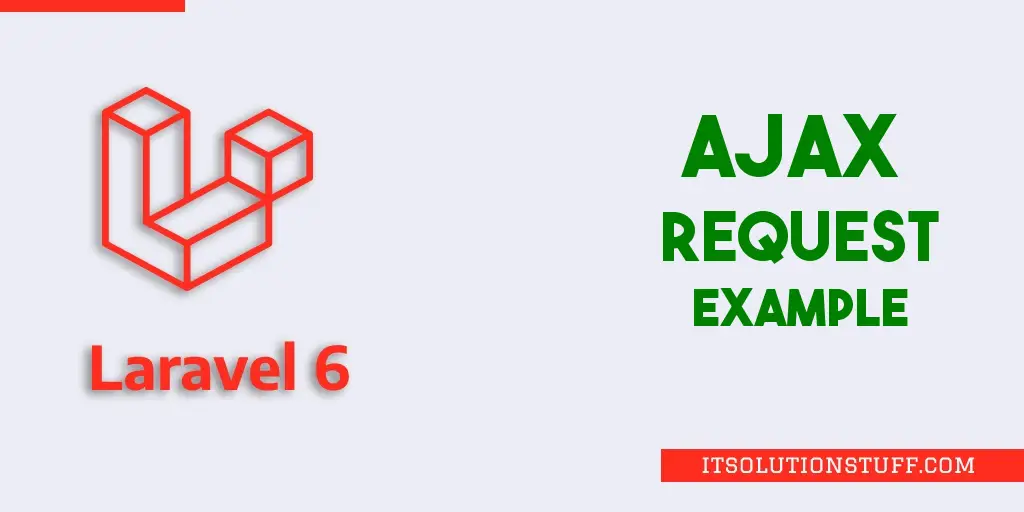Laravel 6 Ajax Request Example
Here, i will guide you how to write jquery ajax form submit in laravel 6. we will write jquery ajax post request laravel 6. we will protect csrf token with ajax request in laravel 6. I will give you very simple example of laravel 6 ajax post request tutorial. you can easily use ajax get request, ajax post request, ajax put request, ajax delete request ect with laravel 6.
Ajax request is a basic requirement of any php project, we are always looking for without page refresh data should store in database and it's possible only by jquery ajax request. same thing if you need to write ajax form submit in laravel 6 then i will help you how you can pass data with ajax request and get on controller. If you want to see all request example like get, post, delete, put then you can see on laravel 6 ajax crud example, i write few days ago. You can read from here: Laravel 6 Ajax CRUD.
If you want to add ajax request with validation then you can follow this article: Laravel 6 Ajax Form Validation
You have to just do three things to understand how to use ajax request in laravel 6, so just follow this three step and you will learn how to use ajax request in your laravel 6 application.

Step 1: Create Routes
First thing is we put two routes in one for displaying view and another for post ajax. So simple add both routes in your route file.
routes/web.php
Route::get('ajaxRequest', 'AjaxController@ajaxRequest');
Route::post('ajaxRequest', 'AjaxController@ajaxRequestPost')->name('ajaxRequest.post');
Step 2: Create Controller
Same things as above for routes, here we will add two new method for routes. One will handle view layout and another for post ajax request method, so let's add bellow:
app/Http/Controllers/HomeController.php
<?php
namespace App\Http\Controllers;
use Illuminate\Http\Request;
class AjaxController extends Controller
{
/**
* Create a new controller instance.
*
* @return void
*/
public function ajaxRequest()
{
return view('ajaxRequest');
}
/**
* Create a new controller instance.
*
* @return void
*/
public function ajaxRequestPost(Request $request)
{
$input = $request->all();
\Log::info($input);
return response()->json(['success'=>'Got Simple Ajax Request.']);
}
}
Step 3: Create Blade File
Finally we require to create ajaxRequest.blade.php file and here we will write code of jquery ajax and pass laravel token. So blade file is very important in ajax request. So let's see bellow file:
resources/views/ajaxRequest.blade.php
<!DOCTYPE html>
<html>
<head>
<title>Laravel 6 Ajax Request example</title>
<meta charset="utf-8">
<meta http-equiv="X-UA-Compatible" content="IE=edge">
<meta name="viewport" content="width=device-width, initial-scale=1">
<link href="//netdna.bootstrapcdn.com/bootstrap/3.2.0/css/bootstrap.min.css" rel="stylesheet">
<script src = "https://ajax.googleapis.com/ajax/libs/jquery/2.1.3/jquery.min.js"></script>
<meta name="csrf-token" content="{{ csrf_token() }}" />
</head>
<body>
<div class="container">
<h1>Laravel 6 Ajax Request example</h1>
<form >
<div class="form-group">
<label>Name:</label>
<input type="text" name="name" class="form-control" placeholder="Name" required="">
</div>
<div class="form-group">
<label>Password:</label>
<input type="password" name="password" class="form-control" placeholder="Password" required="">
</div>
<div class="form-group">
<strong>Email:</strong>
<input type="email" name="email" class="form-control" placeholder="Email" required="">
</div>
<div class="form-group">
<button class="btn btn-success btn-submit">Submit</button>
</div>
</form>
</div>
</body>
<script type="text/javascript">
$.ajaxSetup({
headers: {
'X-CSRF-TOKEN': $('meta[name="csrf-token"]').attr('content')
}
});
$(".btn-submit").click(function(e){
e.preventDefault();
var name = $("input[name=name]").val();
var password = $("input[name=password]").val();
var email = $("input[name=email]").val();
$.ajax({
type:'POST',
url:"{{ route('ajaxRequest.post') }}",
data:{name:name, password:password, email:email},
success:function(data){
alert(data.success);
}
});
});
</script>
</html>
now you can run your example and see.
You will get output like as bellow:
Output
[2019-09-17 03:54:19] local.INFO: array (
'name' => 'Hardik Savani',
'password' => '123456',
'email' => 'aatmaninfotech@gmail.com',
)
I hope it can help you

